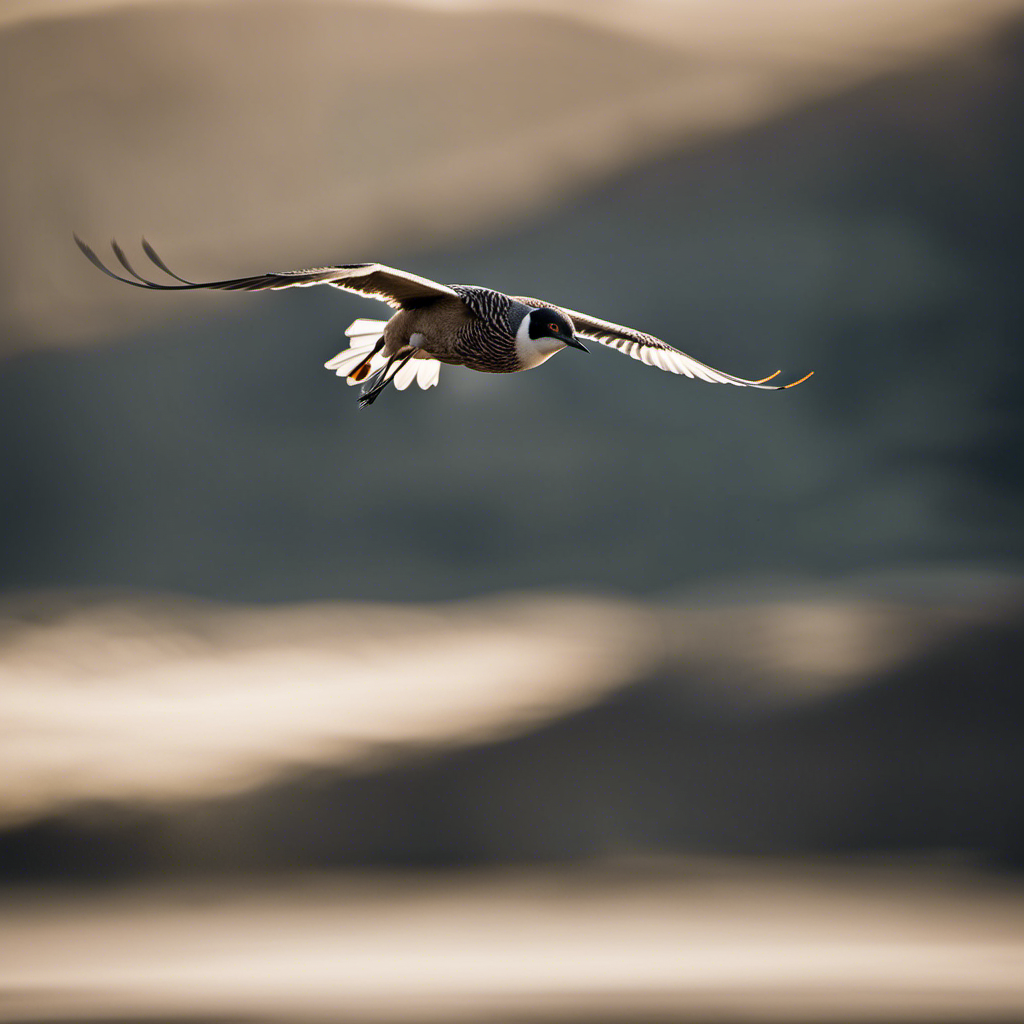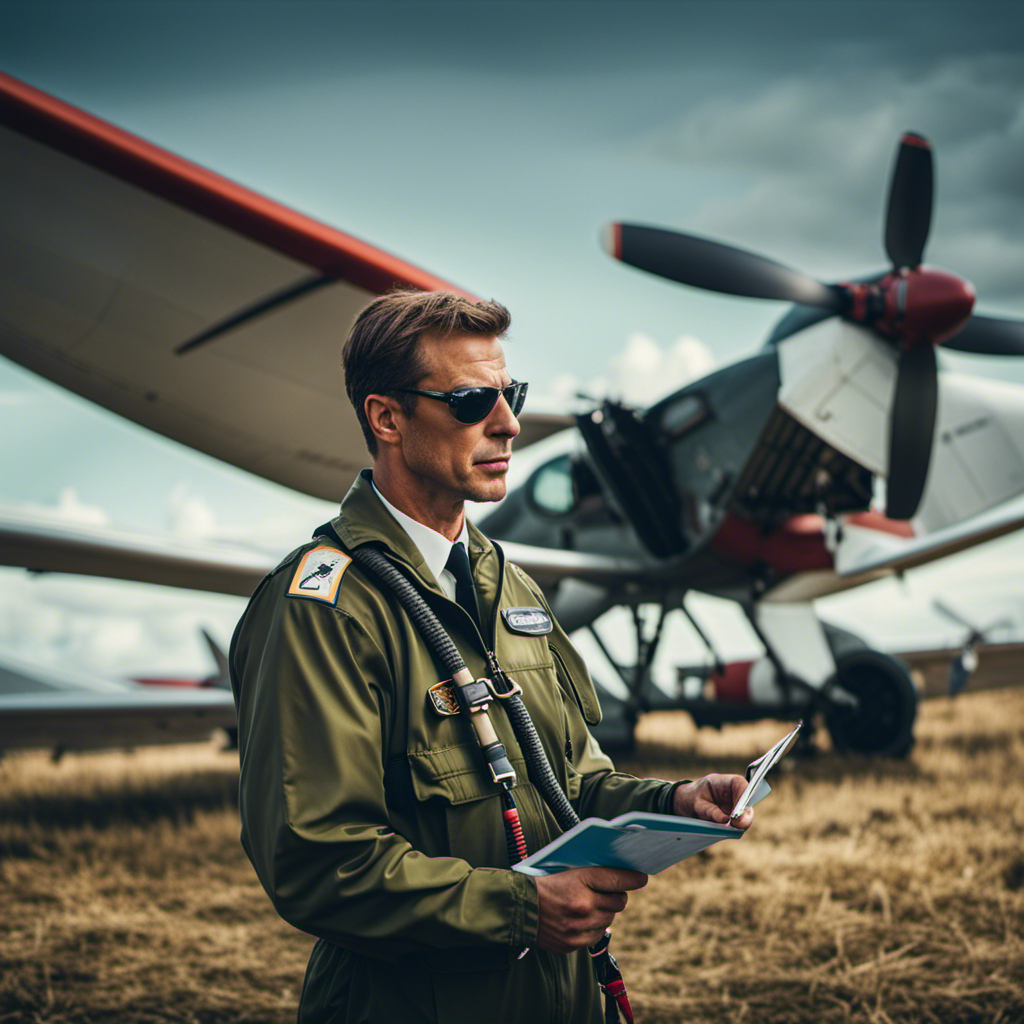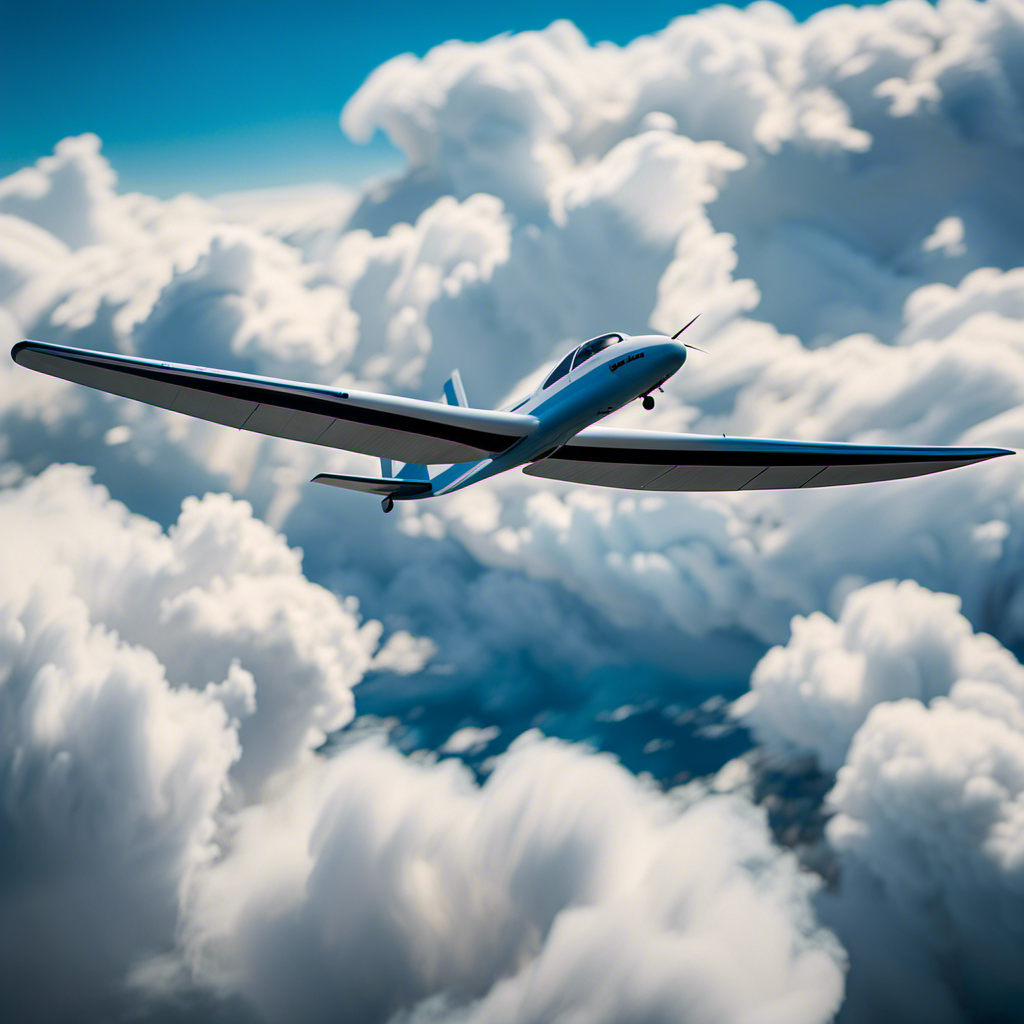While gliding through the vast blue sky, a constant question lingers in my mind: what is the driving force behind the graceful flight of gliding birds?
This article delves into the scientific intricacies behind their effortless aerial maneuvers. Through detailed observations and evidence, we will explore the role of thermals, the efficient wing design, and the utilization of wind currents in sustaining their flight.
Join me on this journey of discovery as we uncover the fascinating adaptations and evolution of these remarkable creatures.
Key Takeaways
- Soaring birds utilize thermals, updrafts, and wind patterns to power their flight.
- Wing design and flight techniques, such as long and narrow wings with high aspect ratios, enhance lift and reduce drag for sustained flight.
- Wing loading, which is influenced by wing shape and feather structure, affects the ability of birds to take advantage of wind currents.
- Soaring birds rely on celestial navigation, magnetic fields, landmarks, and atmospheric conditions to navigate during their long-distance migrations.
The Role of Thermals in Soaring Bird Flight
Thermals play a crucial role in the flight of soaring birds. As an ornithologist, I have observed that thermals serve as a source of energy for these birds during migration and soaring flight.
Thermals are columns of warm air that rise from the Earth’s surface due to uneven heating. When birds encounter these thermals, they can gain altitude without flapping their wings, conserving their energy for long-distance flights. This is particularly important during migration, as birds need to cover vast distances to reach their breeding or wintering grounds.
When a bird enters a thermal, it uses its keen sense of flight dynamics to detect the updraft and adjust its wing position accordingly. By circling within the thermal, the bird can maintain its altitude or even gain height, allowing it to travel long distances without expending much energy. This behavior is commonly observed in raptors like hawks and eagles, as well as in birds like vultures and storks.
By harnessing the power of thermals, soaring birds are able to navigate efficiently and cover great distances during migration. This remarkable adaptation demonstrates the incredible abilities of these avian species.
Transitioning into the subsequent section about harnessing the power of updrafts, we can explore how birds utilize other atmospheric features to aid their flight.
Harnessing the Power of Updrafts
Updrafts are essential for birds to efficiently navigate through the air and conserve energy. These upward currents of air, caused by various factors such as terrain and thermal activity, can be harnessed by birds to gain altitude and maintain flight without expending excessive energy. By exploiting updrafts, birds are able to effectively harness wind energy and extend their flight time.
To better understand how birds utilize updrafts, let’s take a look at some observations and data:
| Updraft Type | Description | Example |
|---|---|---|
| Ridge Soaring | Birds use the upward wind produced by a ridge or cliff edge to gain altitude and fly along the ridge. | Alpine choughs soaring along mountain ridges. |
| Thermal Soaring | Birds make use of thermals, columns of rising warm air, to gain altitude and stay aloft. | Hawks circling in a thermal updraft. |
| Convergence Soaring | Birds exploit the convergence of air masses, such as sea breezes or wind fronts, to gain lift and travel long distances. | Seabirds soaring along the coastlines. |
By effectively exploiting updrafts, birds can conserve their energy and cover vast distances with minimal effort. This ability to harness wind energy is crucial for their survival and successful migration.
With a clear understanding of how birds utilize updrafts, we can now delve into the efficient wing design of soaring birds, which further enhances their ability to navigate the skies without undue energy expenditure.
The Efficient Wing Design of Soaring Birds
To truly appreciate how soaring birds effortlessly glide through the air, take a moment to examine the remarkable efficiency of their wing design. These birds have evolved a wing shape that is specifically adapted for efficient flight and maximum aerodynamic lift. Here are five characteristics of their wing design:
- Long and Narrow: Soaring birds have long wings that are narrow in shape. This allows for reduced drag and helps them maintain steady flight.
- High Aspect Ratio: The wings of these birds have a high aspect ratio, which means they are long and slender. This increases their lift-to-drag ratio, enabling them to stay aloft for extended periods.
- Slotted Wingtips: Many soaring birds possess slotted wingtips, which create vortices that enhance lift and reduce drag. This feature allows them to maintain stability and control during flight.
- Flexible Wing Structure: The wings of these birds are flexible, allowing them to adjust their shape and angle of attack to optimize lift and maneuverability in different wind conditions.
- Wing Loading: Soaring birds have a low wing loading, meaning their body weight is evenly distributed across a larger wing area. This enables them to stay airborne with minimal effort.
Utilizing Wind Currents for Sustained Flight
When you’re soaring through the air, you can take advantage of the wind currents to sustain your flight effortlessly. Soaring birds have evolved remarkable adaptations that allow them to exploit these wind patterns and employ efficient gliding techniques. As an ornithologist, I have observed that these birds possess unique physical and behavioral characteristics that enable them to navigate the skies with precision.
One key aspect of utilizing wind patterns is understanding the concept of dynamic soaring. This technique involves exploiting the vertical wind shear, which is the change in wind speed and direction with altitude. Soaring birds capitalize on this phenomenon by alternating between ascending and descending flight, using the updrafts and downdrafts to gain and maintain altitude. Additionally, they adjust their flight speed and angle to optimize their energy expenditure.
Furthermore, gliding techniques play a crucial role in sustaining flight. Soaring birds possess long, broad wings that allow them to maximize lift and minimize drag. These wings enable them to glide effortlessly for extended periods, conserving energy in the process. The birds’ flight patterns also involve soaring in circles or figure-eight patterns, which help them stay within the rising air currents.
Understanding how birds utilize wind patterns and employ gliding techniques is essential for comprehending the mechanics of sustained flight. It provides valuable insights into the energy-efficient strategies that these birds have evolved.
Transitioning to the next section, it is crucial to explore the importance of wing loading in soaring, as it directly influences the birds’ ability to take advantage of wind currents for sustained flight.
The Importance of Wing Loading in Soaring
Understanding the importance of wing loading is crucial in comprehending how wind currents can be utilized for sustained flight. Wing loading refers to the amount of weight that is supported by a bird’s wing area. It is a fundamental aspect of wing structure that directly affects lift generation.
Here are some key points to consider:
- Wing loading plays a significant role in determining a bird’s flight capabilities. Birds with higher wing loading require more energy to maintain flight and may have limited maneuverability.
- The ratio of wing area to body mass is a critical factor in achieving optimal wing loading. Birds with larger wings relative to their body size tend to have lower wing loading and can take advantage of wind currents more effectively.
- Wing loading affects a bird’s ability to soar and glide effortlessly. Birds with lower wing loading can exploit rising air currents for sustained flight, while those with higher wing loading may struggle to stay aloft without constant flapping.
- Different bird species have evolved various strategies to adapt their wing loading for specific flight requirements. This includes altering wing shape, aspect ratio, and feather structure.
Understanding the importance of wing loading provides valuable insights into the mechanics of bird flight and how they interact with wind currents. This knowledge sets the foundation for further exploration into the intricate techniques birds employ, such as understanding dynamic soaring techniques.
Understanding Dynamic Soaring Techniques
Transition: Now that we have discussed the importance of wing loading in soaring, it is crucial to delve into the fascinating world of dynamic soaring techniques employed by seabirds.
Current Subtopic: Understanding Dynamic Soaring Techniques
Dynamic soaring is a remarkable flight strategy employed by certain seabird species, such as albatrosses and shearwaters, to harness the energy from wind and waves. These birds are masterful in utilizing the complex interplay between air currents and ocean waves to maintain sustained flight with minimal energy expenditure.
To better understand the intricacies of dynamic soaring, let’s explore the impact of turbulence on this flight technique. Turbulence, caused by variations in wind speed and direction, plays a significant role in shaping the flight dynamics of soaring birds. By skillfully maneuvering through turbulent air masses, these birds can extract additional energy, propelling them further and faster across vast oceanic expanses.
In order to visually represent the concept of dynamic soaring and its relationship with turbulence, I have created a table below:
| Dynamic Soaring Techniques | Impact of Turbulence |
|---|---|
| Constant altitude changes | Enhanced energy gain |
| Precise flight path | Increased flight speed |
| Efficient energy transfer | Improved maneuverability |
| Adaptability to wind conditions | Enhanced flight endurance |
As we can see from the table, dynamic soaring techniques in seabirds allow them to effectively navigate through turbulent air masses, maximizing their energy gain and flight performance.
Transition: Now that we have explored the intricacies of dynamic soaring and its interaction with turbulence, let us delve into the influence of weather patterns on soaring flight.
The Influence of Weather Patterns on Soaring
Weather patterns play a crucial role in determining the availability and strength of the air currents that soaring seabirds rely on for efficient flight. These atmospheric conditions have a significant impact on the flight patterns and navigation abilities of these magnificent birds.
Here are four key ways in which weather patterns influence the flight of soaring birds:
-
Wind patterns: Strong and consistent winds provide the necessary lift and support for soaring birds to stay aloft for extended periods. They can take advantage of updrafts and thermals created by wind patterns to gain altitude and cover long distances.
-
Air pressure systems: Variations in air pressure across different regions affect the formation of wind currents, which in turn influence the flight paths of soaring birds. High-pressure systems can create favorable conditions for soaring, while low-pressure systems may disrupt their flight patterns.
-
Temperature gradients: Differences in temperature between land and sea can generate thermal updrafts, which are essential for soaring birds to maintain their flight. They rely on these thermals to gain altitude without expending much energy.
-
Precipitation and cloud cover: Rain and clouds can obstruct the availability of thermals and updrafts, making it more challenging for soaring birds to find the necessary air currents for sustained flight.
Understanding the influence of atmospheric conditions and the impact of wind patterns is crucial for studying the flight behaviors of soaring birds. It allows us to gain insights into their remarkable abilities to navigate and cover long distances effortlessly.
In the next section, we will explore how these birds utilize their navigation skills to embark on extraordinary journeys.
How Soaring Birds Navigate Long Distances
Soaring birds rely on their exceptional navigational abilities to embark on extraordinary journeys, effortlessly covering long distances. These birds showcase remarkable long distance migration, with some species traveling thousands of kilometers each year.
One of the key factors enabling their successful navigation is celestial navigation. By observing the sun, stars, and other celestial bodies, soaring birds are able to orient themselves and maintain a steady course. They possess a specialized visual system that allows them to perceive and interpret subtle changes in the position of celestial bodies, which in turn helps them to adjust their flight path accordingly. Additionally, research has shown that these birds utilize other cues such as magnetic fields, landmarks, and even atmospheric conditions to enhance their navigational skills.
The ability of soaring birds to navigate long distances is truly awe-inspiring. Their precise and efficient navigation strategies ensure they reach their intended destinations with remarkable accuracy. This remarkable navigational prowess sets the stage for the next section, where we will explore the energy efficiency of soaring flight and how these birds are able to sustain their arduous journeys.
The Energy Efficiency of Soaring Flight
As you glide effortlessly through the air, your body harnesses the energy of the wind to maintain efficient and sustainable flight. Soaring flight is a remarkable adaptation that allows birds to cover long distances with minimal effort.
Let’s explore the physics behind this incredible feat and the metabolic advantages it provides.
-
Lift: Soaring birds take advantage of rising air currents, such as thermals and updrafts, to gain altitude and maintain flight. These air movements are created by temperature and pressure differentials in the atmosphere.
-
Wing shape: The wings of soaring birds are long and broad, with a high aspect ratio. This design allows for increased lift generation and reduced drag, enabling birds to stay airborne for extended periods.
-
Energy conservation: By soaring, birds can minimize their energy expenditure. They use the wind to provide the necessary lift and reduce the need for constant flapping, conserving valuable metabolic resources.
-
Gliding techniques: Soaring birds employ various gliding techniques, such as dynamic soaring and slope soaring, to maximize their flight efficiency. They make use of wind gradients and take advantage of different wind patterns to maintain their altitude and speed.
Understanding the physics behind soaring flight and the metabolic advantages it offers is crucial for appreciating the remarkable abilities of these birds.
Now, let’s delve into the adaptations and evolution of soaring birds, which have allowed them to become masters of the skies.
The Adaptations and Evolution of Soaring Birds
The energy efficiency of soaring flight allows birds to cover great distances with minimal effort. Now, let’s delve into the fascinating adaptations and evolution of soaring birds, specifically their adaptations for gliding and the evolution of wing shape.
Adaptations for gliding are essential for birds to maintain stable flight while minimizing energy expenditure. One crucial adaptation is the presence of long, broad wings. These wings provide a large surface area, generating lift and enabling birds to stay airborne for extended periods. Additionally, the wing feathers of soaring birds possess specialized structures, such as overlapping barbs and hooked barbules, which create a smooth and streamlined wing surface, reducing air resistance.
The evolution of wing shape among soaring birds has been shaped by selective pressures for efficient gliding. For instance, species that soar in open environments, like eagles and vultures, have long and broad wings, allowing them to soar effortlessly in thermals and exploit updrafts. In contrast, birds that soar in forested areas, such as hawks and falcons, have shorter and more rounded wings, enabling them to maneuver through dense vegetation.
Understanding these adaptations and the evolution of wing shape in soaring birds provides valuable insights into the remarkable abilities of these avian marvels. By studying their adaptations, we can gain a deeper appreciation for the intricate mechanisms that enable birds to effortlessly glide through the skies.
Frequently Asked Questions
How do soaring birds use thermals to gain altitude?
Soaring birds use thermals to gain altitude by taking advantage of rising columns of warm air. These thermals are created by the heating of the Earth’s surface, which in turn creates wind patterns. This strategy is crucial for bird migration and enables energy-efficient flight.
What are the different types of updrafts that soaring birds rely on?
Soaring birds rely on two types of updrafts: ridge lift and convergence lift. Ridge lift occurs when wind encounters a slope or ridge, causing it to rise and create an upward force. Convergence lift occurs when two air masses with different temperatures and densities meet, causing the warmer, lighter air to rise.
How do the wing design and shape of soaring birds contribute to their efficient flight?
The wing morphology and aerodynamics of soaring birds contribute to their efficient flight. Their long, broad wings and specialized feathers allow for increased lift and reduced drag, enabling them to effortlessly glide and soar for extended periods.
What are some techniques that soaring birds use to navigate long distances?
Soaring birds utilize a variety of gliding techniques to navigate long distances. They rely on their keen sense of the Earth’s magnetic field to guide them, enabling precise navigation and successful migration.
How do weather patterns affect the flight patterns of soaring birds?
The flight patterns of soaring birds are influenced by wind currents and atmospheric pressure. Wind currents provide lift and help birds stay aloft, while changes in atmospheric pressure can affect their ability to navigate and maintain altitude.
Conclusion
In conclusion, the flight of soaring birds is powered by a combination of thermals, updrafts, wind currents, and efficient wing design. These factors allow them to navigate long distances and sustain flight with remarkable energy efficiency.
It is fascinating to note that soaring birds can cover thousands of kilometers during migration, with some species traveling more than 20,000 kilometers in a single journey. This statistic evokes a sense of awe and wonder, highlighting the incredible capabilities and adaptations of these magnificent creatures.
With a heart that soars as high as the skies, Aria, affectionately known as “Skylark,” is the driving force behind Soaring Skyways. Her journey into the gliding world began as a young dreamer gazing up at the soaring birds, yearning to experience the weightlessness and freedom they embodied. With years of experience both in the cockpit and behind the scenes, Aria’s commitment to the gliding community is unwavering.










